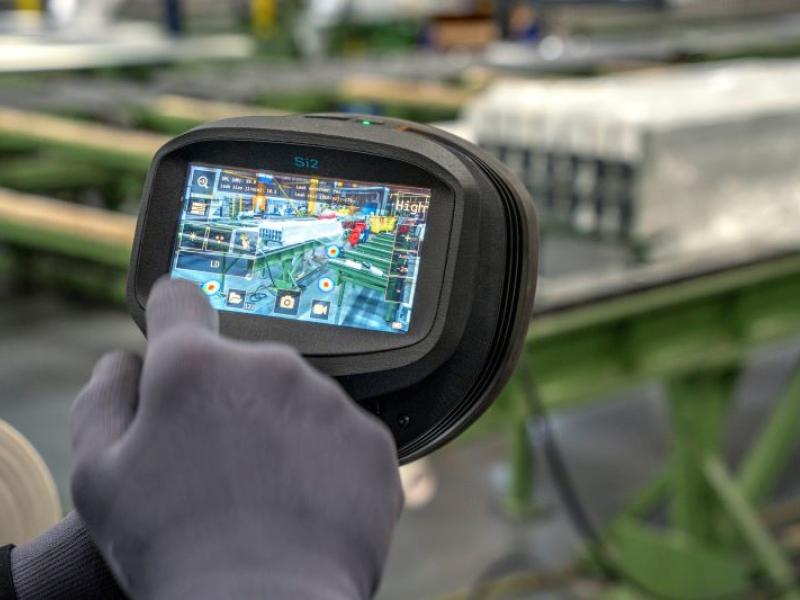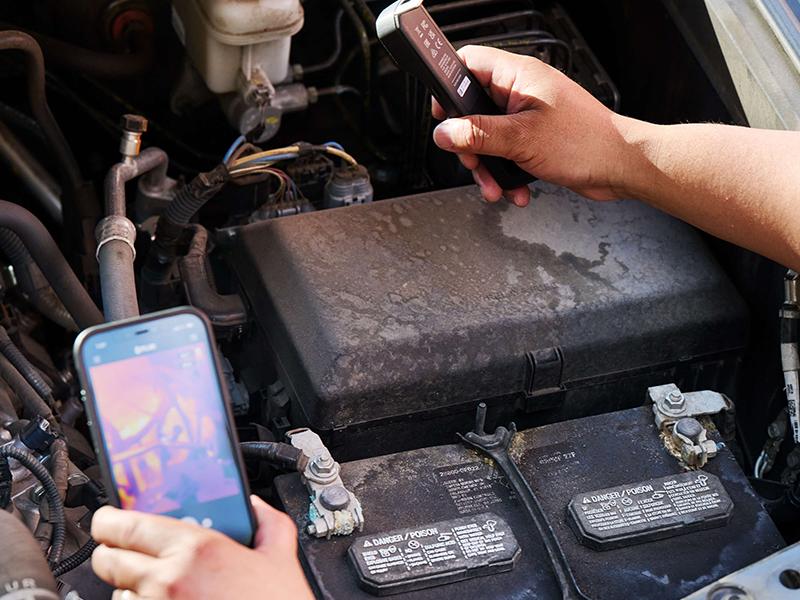New Fluke FieldSense technology enables simultaneous voltage and current measurements – without metallic contact.
For many years, electricians and technicians looking for a quick current reading have reached for the trusted Fluke T5 Electrical Tester, a personal everyday tool seen in tool belts the world over. With the T5, you slide the open fork around a conductor and safely measure ac current up to 100 amps. No need to clamp the fork shut or break the circuit. This “open fork” technology simply saves time and is safer to use than test leads. But the T5 still requires test leads to measure voltage.
Now, Fluke engineers have developed and are patenting a new technology called FieldSense that improves on the open fork functionality by performing not only ac current but also ac voltage and frequency measurements. Voltage and current measurements can be made on one device at the same time, in real time. The Fluke T6 Electrical Tester with FieldSense technology is the first handheld test tool using this new patent-pending technology.
Safer way to test voltage
FieldSense technology is a safer way to accurately measure voltage.
Contacting electrical conductors with test leads or alligator clips requires metal-to-metal contact, which as any electrician or technician knows, carries the potential for arc flash. FieldSense eliminates that step. Because the measurement tool and the voltage source under test are isolated, the person performing the test is safer from potential electrical shock. This is performed by means of galvanic isolation or separation, the principle that isolates functions of an electrical current to prevent current flow. FieldSense takes a measurement of voltage without voltage flowing through the meter. Instead, the Fluke instrument, such as the T6-1000, senses an electrical field in the open fork to make the measurement, a safer method.
And since the measurement is performed through the cable’s insulation, you reduce exposure to metallic conductors. You also decrease the potential for errors, or making contact with the wrong conductor.
How FieldSense works
FieldSense technology is truly a breakthrough in how voltage is measured. While the technology in the T5 detects a magnetic field to derive an ac current measurement, the new technology detects an electrical field. Fluke Research and Development teams first developed the open-fork voltage sensing technology, which involves transducing and calculating a known signal to derive measurements for the source voltage.
This was done by designing the device to generate a reference signal of known amplitude and frequency. Then, when grounded, the resulting composite waveform is detected by an electronic sensor built into the tester. After amplification, processing and digital calculations, voltage and frequency measurements are derived.
The next step after developing voltage sensing, the teams were challenged to combine these two different physical phenomena – magnetic field sensing and electrical field sensing – into one device. After months of prototyping and testing the team was able to determine the optimal design so these two technologies could be paired together. The result is that for the first time in a Fluke meter, voltage and current can be measured and displayed at the same time.
What’s the difference between a voltage detector and FieldSense?
It’s important to distinguish the new FieldSense measurement technology from the variety of voltage detectors on the market. These voltage detectors range from pen style devices that light up when voltage is present to clamp meters that beep or vibrate when a voltage signal is present. The distinction is that a voltage detector generally shows you that voltage is simply present,whereas the FieldSense technology allows you to actually make an accurate voltage measurement.
How to use FieldSense technology
The open fork form factor is intuitive and easy to use. First, if necessary, separate individual hot and neutral wires. Then, slide the open fork over the hot wire (or neutral if the equipment is in operation). That’s it. You now get a measurement. The open fork also makes it easier to isolate individual wires in a panel, which can be difficult when many wires are bundled. In many cases, the measurement can be made with one hand. That’s also a safer practice.
The benefits, include:
- Safer voltage measurements without having to connect meters in parallel.
- Faster troubleshooting by being able to measure through the fork directly around a conductor
- The ability to make voltage and current readings at the same time
Who will use testers with FieldSense?
Open fork test tools that can measure voltage, current and frequency are helpful for electrical troubleshooting workflows in many job roles. Some of the people who will find this technology useful include:
- Electricians
- Electrical contractors
- HVAC technicians
- Field service engineers
- Maintenance technicians
Applications
Test tools with FieldSense are extremely versatile for troubleshooting and maintenance while gaining access to previously inaccessible measurement points such as a junction box.
General applications
- Quickly check if a circuit is live before starting work
- Quickly measure individual voltages (either ac using FieldSense or dc using test leads)
- Quickly measure current through the open fork up to 200 A
- Determine component resistances up to 100 kΩ
- Check circuit continuity
Residential applications
- Quickly measure loads on a branch circuit at a service panel
- Quickly measure the load side voltage of a circuit breaker or fuse
- Map outlets to breakers.
Industrial applications
- Quickly check circuit loading at panelboards (including feeder cables, branch circuits, and neutrals) and the integrity of a grounding circuit
- Feed circuits coming into motors (up to 200 amps)
To learn more and order go to: www.fluke.com/auen/t6
Phone: +61 2 8850 3333
auinfo@fluke.com
www.fluke.co.nz






